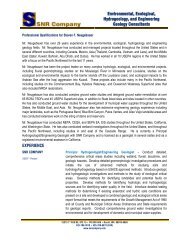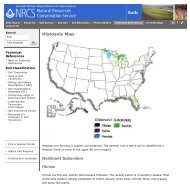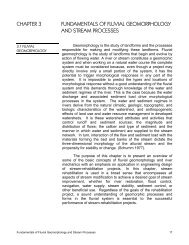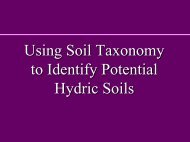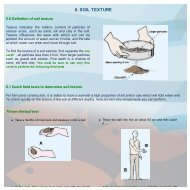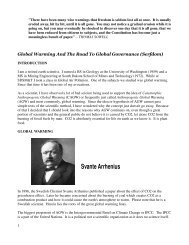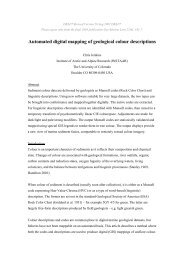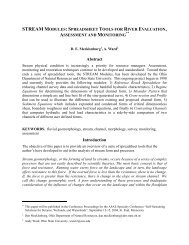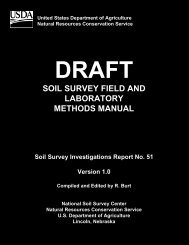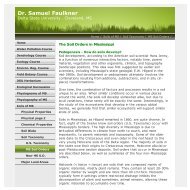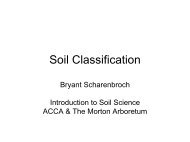SSAGR246_AG151_ Application of the Soil Taxonomy Key to the ...
SSAGR246_AG151_ Application of the Soil Taxonomy Key to the ...
SSAGR246_AG151_ Application of the Soil Taxonomy Key to the ...
Create successful ePaper yourself
Turn your PDF publications into a flip-book with our unique Google optimized e-Paper software.
All soils in <strong>the</strong> world can be classified within 12 different soil orders (<strong>Soil</strong> Survey Staff, 1999; Figure 1). The names <strong>of</strong> soil orders end with<br />
<strong>the</strong> formative element “sol” (from Latin solum, soil or ground) (Table 1). The His<strong>to</strong>sol soil order includes most <strong>of</strong> <strong>the</strong> world's organic soils,<br />
with <strong>the</strong> formative element “Hist” (from Greek his<strong>to</strong>s, tissue) indicating <strong>the</strong> presence <strong>of</strong> organically-derived soil material. A portion <strong>of</strong> this<br />
formative element (“ist”) is consistently used as a suffix within <strong>the</strong> names <strong>of</strong> all His<strong>to</strong>sol soils. This suffix appears in soil names at <strong>the</strong><br />
suborder, great group, and subgroup levels. Thus, any soil name ending with “ist” (such as Torrifolist, Sphagn<strong>of</strong>ibrist, Sulfihemist, or<br />
Cryosaprist) is an organic His<strong>to</strong>sol.<br />
In general, soils are classified as His<strong>to</strong>sols when more than half <strong>of</strong> <strong>the</strong> upper 80 cm (32 inches) <strong>of</strong> <strong>the</strong> soil is highly organic, or in <strong>the</strong><br />
case <strong>of</strong> shallow soils, if organic material <strong>of</strong> any thickness resides above bedrock or within fragmental material containing voids filled with<br />
organic materials. Under <strong>the</strong> latest taxonomic key (<strong>Soil</strong> Survey Staff, 1998; 1999), organic soils in extremely cold environments are now<br />
classified as Histels, a suborder within <strong>the</strong> new Gelisol soil order (<strong>the</strong> suffix “el” in Histel is derived from “Gel”, indicating that <strong>the</strong> soil is a<br />
Gelisol).The organic soils in <strong>the</strong> EAA are classified within <strong>the</strong> His<strong>to</strong>sol soil order, based on high organic matter composition and <strong>the</strong><br />
absence <strong>of</strong> consistently frigid conditions.<br />
<strong>Soil</strong> Suborder<br />
The 12 soil orders collectively represent 64 soil suborders (<strong>Soil</strong> Survey Staff, 1999). His<strong>to</strong>sols can be classified in<strong>to</strong> four different<br />
suborders, including Folists, Fibrists, Hemists, and Saprists (Figure 1). The suborder Folist (from Latin folia, leaf) describes a group <strong>of</strong><br />
organic soils that have formed under non-flooded conditions, composed <strong>of</strong> leaf litter and decaying wood fragments that have accumulated<br />
over bedrock, a scenario found in some forested environments.<br />
Organic soils that formed under flooded conditions are represented by <strong>the</strong> remaining three suborders, which differ based on <strong>the</strong> extent <strong>of</strong><br />
organic fiber decomposition. <strong>Soil</strong>s composed <strong>of</strong> organically-derived material that exhibit <strong>the</strong> least amount <strong>of</strong> decay are classified as<br />
Fibrists (from Latin fibra, fiber). Fibrists generally contain three-fourths or more (by volume) fibers that are retained on a 100-mesh sieve<br />
(0.15 mm openings). Due <strong>to</strong> <strong>the</strong> absence <strong>of</strong> appreciable decomposition, plant cellular structures are still clearly visible within individual<br />
fibers. Fibrists will generally have <strong>the</strong> lowest bulk densities (< 0.10 gm cm -3 ), lowest ash contents (or greatest organic matter contents),<br />
and highest saturated gravimetric water contents (850-3000% on an oven-dry basis) (McCollum et al., 1976). At <strong>the</strong> o<strong>the</strong>r extreme are <strong>the</strong><br />
Saprists, with soil pr<strong>of</strong>iles dominated by soils exhibiting <strong>the</strong> greatest evidence <strong>of</strong> decomposition. Fiber contents after rubbing are less<br />
than one-sixth (by volume). Saprists are predominately black in color, with bulk densities generally exceeding 0.20 gm cm -3 and saturated<br />
gravimetric water contents less than 450% (McCollum et al., 1976). Hemists (from Greek hemi, half; implying an intermediate stage <strong>of</strong><br />
decomposition) represent those His<strong>to</strong>sols that exhibit a decomposition stage that is intermediate between <strong>the</strong> less decomposed Fibrists<br />
and more thoroughly decomposed Saprists. Physical characteristics (bulk density, saturated gravimetric water content) are also<br />
intermediate in value.<br />
The black organic “muck” soils <strong>of</strong> <strong>the</strong> EAA are comprised <strong>of</strong> highly decomposed organic materials, and are thus Saprists (from Greek<br />
saprose, rotten; implying a high degree <strong>of</strong> decomposition) (Table 1).<br />
<strong>Soil</strong> Great Group<br />
Descriptions at <strong>the</strong> great group level seek <strong>to</strong> identify distinctive differences across various soils found within a given soil suborder. This



